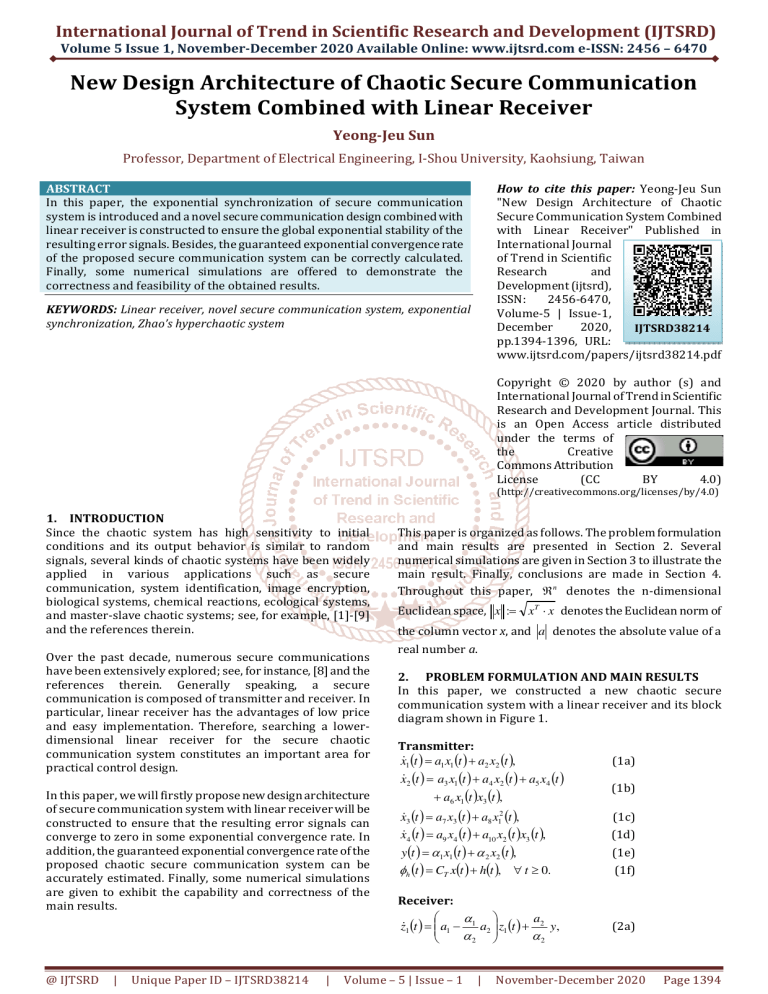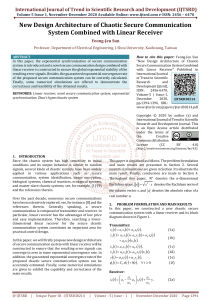
International Journal of Trend in Scientific Research and Development (IJTSRD)
Volume 5 Issue 1, November-December 2020 Available Online: www.ijtsrd.com e-ISSN: 2456 – 6470
New Design Architecture of Chaotic Secure Communication
System Combined with Linear Receiver
Yeong-Jeu Sun
Professor, Department of Electrical Engineering, I-Shou University, Kaohsiung, Taiwan
How to cite this paper: Yeong-Jeu Sun
"New Design Architecture of Chaotic
Secure Communication System Combined
with Linear Receiver" Published in
International Journal
of Trend in Scientific
Research
and
Development (ijtsrd),
ISSN:
2456-6470,
Volume-5 | Issue-1,
December
2020,
IJTSRD38214
pp.1394-1396, URL:
www.ijtsrd.com/papers/ijtsrd38214.pdf
ABSTRACT
In this paper, the exponential synchronization of secure communication
system is introduced and a novel secure communication design combined with
linear receiver is constructed to ensure the global exponential stability of the
resulting error signals. Besides, the guaranteed exponential convergence rate
of the proposed secure communication system can be correctly calculated.
Finally, some numerical simulations are offered to demonstrate the
correctness and feasibility of the obtained results.
KEYWORDS: Linear receiver, novel secure communication system, exponential
synchronization, Zhao’s hyperchaotic system
Copyright © 2020 by author (s) and
International Journal of Trend in Scientific
Research and Development Journal. This
is an Open Access article distributed
under the terms of
the
Creative
Commons Attribution
License
(CC
BY
4.0)
(http://creativecommons.org/licenses/by/4.0)
1. INTRODUCTION
Since the chaotic system has high sensitivity to initial
conditions and its output behavior is similar to random
signals, several kinds of chaotic systems have been widely
applied in various applications such as secure
communication, system identification, image encryption,
biological systems, chemical reactions, ecological systems,
and master-slave chaotic systems; see, for example, [1]-[9]
and the references therein.
Over the past decade, numerous secure communications
have been extensively explored; see, for instance, [8] and the
references therein. Generally speaking, a secure
communication is composed of transmitter and receiver. In
particular, linear receiver has the advantages of low price
and easy implementation. Therefore, searching a lowerdimensional linear receiver for the secure chaotic
communication system constitutes an important area for
practical control design.
In this paper, we will firstly propose new design architecture
of secure communication system with linear receiver will be
constructed to ensure that the resulting error signals can
converge to zero in some exponential convergence rate. In
addition, the guaranteed exponential convergence rate of the
proposed chaotic secure communication system can be
accurately estimated. Finally, some numerical simulations
are given to exhibit the capability and correctness of the
main results.
@ IJTSRD
|
Unique Paper ID – IJTSRD38214
|
This paper is organized as follows. The problem formulation
and main results are presented in Section 2. Several
numerical simulations are given in Section 3 to illustrate the
main result. Finally, conclusions are made in Section 4.
Throughout this paper, ℜ n denotes the n-dimensional
Euclidean space, x := xT ⋅ x denotes the Euclidean norm of
the column vector x, and a denotes the absolute value of a
real number a.
2. PROBLEM FORMULATION AND MAIN RESULTS
In this paper, we constructed a new chaotic secure
communication system with a linear receiver and its block
diagram shown in Figure 1.
Transmitter:
x&1 (t ) = a1 x1 (t ) + a2 x2 (t ),
x& 2 (t ) = a3 x1 (t ) + a4 x2 (t ) + a5 x4 (t )
+ a6 x1 (t )x3 (t ),
x&3 (t ) = a7 x3 (t ) + a8 x12 (t ),
x&4 (t ) = a9 x4 (t ) + a10 x2 (t )x3 (t ),
y (t ) = α1 x1 (t ) + α 2 x2 (t ),
φh (t ) = CT x(t ) + h(t ), ∀ t ≥ 0.
Receiver:
α
a
z&1 (t ) = a1 − 1 a2 z1 (t ) + 2 y,
α2
α2
Volume – 5 | Issue – 1
|
(1a)
(1b)
(1c)
(1d)
(1e)
(1f)
(2a)
November-December 2020
Page 1394
International Journal of Trend in Scientific Research and Development (IJTSRD) @ www.ijtsrd.com eISSN: 2456-6470
z2 (t ) =
−α1
α2
z1 (t ) +
1
α2
y (t ),
It yields that
ψ 1 (t ) = e −αtψ 1 (0),
ψ (t ) = − α1 e −αtψ (0), ∀ t ≥ 0.
1
2
α2
(2b)
h1 (t ) = φh (t ) − CR z (t ), ∀ t ≥ 0,
(2c)
where x(t ) := [x1 (t ) x2 (t ) x3 (t ) x4 (t )] ∈ℜ 4×1 is the state
(5)
T
vector of transmitter, y (t ) ∈ℜ is the output of transmitter,
z (t ) := [z1 (t ) z 2 (t )] ∈ℜ 2×1 is the state vector of receiver,
T
CT = [α3 α 4 0 0]∈ℜ1×4 , CR = [α 3 α 4 ]∈ℜ1×2 , ai , i ∈ {1,2,L,10}
are system’s parameters with a2 ≠ 0 , α i , i ∈ {1,2,3,4} are
custom parameters of communication system with
α1
a2 > a1 , h(t ) is the information vector, and h1 (t ) is the
α2
signal recovered from h(t ) . It is worth mentioning that the
Zhao’s chaotic system is the special case of the system (1)
with
a1 = − a2 = −20, a3 = 14, a4 = −11.9,
(3a)
a5 = 1, a6 = −1, a7 = −2.5, a8 = 1 .
a8 = 1, a9 = 0.19, a10 = −0.1 .
(3b)
(3b)
It can be readily obtained that
e(t ) = h1 (t ) − h(t )
= φh (t ) − α 3 z1 (t ) − α 4 z 2 (t ) − φh (t )
+ α 3 x1 (t ) + α 4 x2 (t )
= α 3ψ 1 (t ) + α 4ψ 2 (t )
≤ α 3ψ 1 (t ) + α 4ψ 2 (t )
αα
≤ α 3ψ 1 (0 ) + 1 4 ψ 1 (0) e −αt , ∀ t ≥ 0,
α2
in view of (1), (2), and (5). This completes the proof.
Remark 1: It should be pointed out that the proposed
receiver of (2) is linear and has dual advantages of low price
and easy implementation by electronic circuit.
Besides, it has been verified in [9] that the Lyapunov
exponent of Zhao’s hyperchaotic system is higher than that
of other well-known chaotic systems. Undoubtedly, a good
secure communication system means that we can recover
the message h(t ) in the receiver system; i.e., the error vector
Remark 2: It has been verified in [9] that the Lyapunov
exponent of Zhao’s chaotic system is higher than that of
other well-known hyperchaotic systems. The higher the
Lyapunov exponent, the greater the sensitivity of the
trajectory of the time-domain signal to the initial value; in
other words, the higher the Lyapunov exponent of a dynamic
system, the more difficult it is to predict its trajectory.
Before presenting the main result, let us introduce a
definition which will be used in the main theorem.
3. NUMERICAL SIMULATIONS
Consider the novel secure communication system of (1)-(3)
with α1 = α 2 = 1, α 3 = 3, α 4 = 4 . By Theorem 1, the
e(t ) := h1 (t ) − h(t ) can converge to zero in some sense.
Definition 1: The system (1) with (2) is called secure
communication system with exponential convergence type if
there are positive numbers k and α such that
e(t ) := h1 (t ) − h(t ) ≤ k exp(− α t ), ∀ t ≥ 0 .
In this case, the positive number α is called the exponential
convergence rate.
Now we present the main results for secure communication
system of (1) with (2).
Theorem 1: The system (1) with (2) is a secure
communication system with exponential convergence type.
Besides, the guaranted exponential convergence rate is given
by
α=
α1
a2 − a1 .
α2
Proof. Define
ψ (t ) = [ψ 1 (t ) ψ 2 (t )]T
= [x1 (t ) − z1 (t ) x2 (t ) − z2 (t )] ∈ ℜ 2 .
T
@ IJTSRD
|
−α1
α2
4. CONCLUSION
In this paper, the exponential synchronization of secure
communication system has been introduced and a new
secure communication design combined with linear receiver
has been developed to guarantee the global exponential
stability of the resulting error signals. Meanwhile, the
guaranteed exponential convergence rate of the proposed
secure communication system can be correctly estimated.
Finally, some numerical simulations have been proposed to
show the effectiveness and feasibility of the obtained results.
ACKNOWLEDGEMENT
The author thanks the Ministry of Science and Technology of
Republic of China for supporting this work under grant MOST
109-2221-E-214-014. Besides, the author is grateful to Chair
Professor Jer-Guang Hsieh for the useful comments.
(4)
Thus, from (1), (2), and (4), one has
α
ψ&1 = x&1 − z&1 = − a1 − 1 a2 (x1 − z1 ) = −αψ 1
α2
and ψ 2 = x2 − z 2 =
synchronization of signals h(t ) and h1 (t ) for the proposed
secure communication (1)-(3) can be achieved with
guaranteed exponential converence rate α = 40 . The real
message h(t ) , the recoverd message h1 (t ) , and the error
signal are depicted in Figure 2-Figure 4, respectively, which
clearly indicateds that the real message h(t ) is recoved after
0.5 seconds.
(x1 − z1 ) = −α1 ψ 1.
α2
Unique Paper ID – IJTSRD38214
|
Volume – 5 | Issue – 1
|
November-December 2020
Page 1395
International Journal of Trend in Scientific Research and Development (IJTSRD) @ www.ijtsrd.com eISSN: 2456-6470
REFERENCES
[1] Raymond S. T. Lee, “Chaotic type-2 transient-fuzzy
deep neuro-oscillatory network (CT2TFDNN) for
worldwide financial prediction,” IEEE Transactions on
Fuzzy Systems, vol. 28, pp. 731-745, 2020.
x (t )
y (t )
CT
[2]
W. Luo, H. Jin, H. Li, X. Fang, and R. Zhou, “Optimal
performance and application for firework algorithm
using a novel chaotic approach,” IEEE Access, vol. 8,
pp. 120798-120817, 2020.
[3]
L. Zhou, F. Tan, and F. Yu, “A robust synchronizationbased chaotic secure communication scheme with
double-layered and multiple hybrid networks,” IEEE
Systems Journal, vol. 14, pp. 2508-2519, 2020.
[4]
[5]
Y. Wang, Z. Li, and J. Sun, “Three-variable chaotic
oscillatory system based on DNA strand displacement
and its coupling combination synchronization,” IEEE
Transactions on NanoBioscience, vol. 19, pp. 434-445,
2020.
+
+ φ (t )
h
h(t )
channel
channel
+
−
h1 (t )
z (t )
CR
Figure 1: Secure-communication scheme ( h(t ) is the
information vector and h1 (t ) is the recovered vector).
10
Z. Hua, Y. Zhang, and Y. Zhou, “Two-dimensional
modular chaotification system for improving chaos
complexity,” IEEE Transactions on Signal Processing,
vol. 68, pp. 1937-1949, 2020.
8
6
4
[7]
Y. Huang, L. Huang, Y. Wang, Y. Peng, and F. Yu, “Shape
synchronization in driver-response of 4-D chaotic
system and its application in image encryption,” IEEE
Access, vol. 8, pp. 135308-135319, 2020.
h(t)
2
[6]
0
-2
-4
L. Zhang, Z. Chen, W. Rao, and Z. Wu, “Efficient and
secure non-coherent OFDM-based overlapped chaotic
chip position shift keying system: design and
performance analysis,” IEEE Transactions on Circuits
and Systems I: Regular Papers, vol. 67, pp. 309-321,
2020.
-6
-8
0
2
4
6
8
10
t (sec.)
12
14
16
18
20
Figure 2: Real message of h(t ) described in the
transmitter of (1).
10
[9]
S. Liu, N. Jiang, A. Zhao, Y. Zhang, and K. Qiu, “Secure
optical communication based on cluster chaos
synchronization in semiconductor lasers network,”
IEEE Access, vol. 8, pp. 11872-11879, 2020.
Y. Zhao, C. Gao, J. Liu, and S. Dong, “A self-perturbed
pseudo-random sequence generator based on
hyperchaos,” Chaos, Solitons & Fractals, vol. 4, pp. 1-8,
2019.
8
6
4
h1(t)
[8]
2
0
-2
-4
[10]
Yeong-Jeu Sun, “A Novel Design of Secure
Communication System with Linear Receiver,” Journal
of Multidisciplinary Engineering Science and
Technology, vol. 4, pp. 8541-8543, 2017.
-6
-8
0
2
4
6
8
10
t (sec.)
12
14
16
18
20
Figure 3: Recoverd message of h1 (t ) described in the
receiver of (2).
0.4
0.2
h1(t)-h(t)
0
-0.2
-0.4
-0.6
-0.8
-1
0
2
4
6
8
10
t (sec.)
12
14
16
18
20
Figure 4: Error signal of h1 (t ) − h(t ) .
@ IJTSRD
|
Unique Paper ID – IJTSRD38214
|
Volume – 5 | Issue – 1
|
November-December 2020
Page 1396





